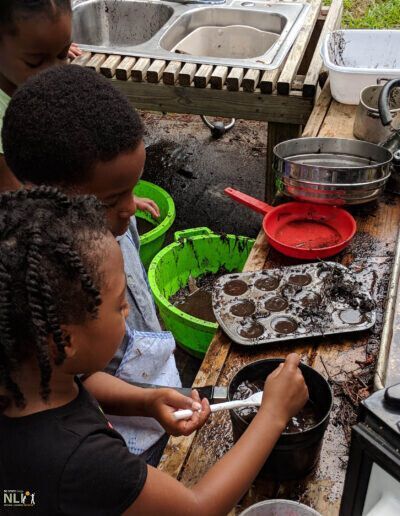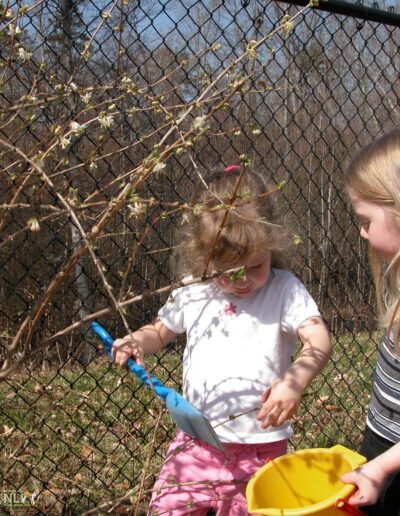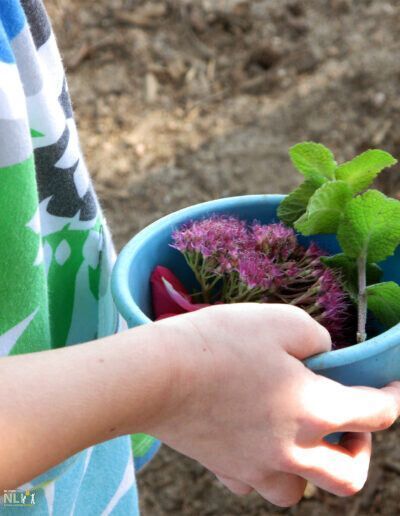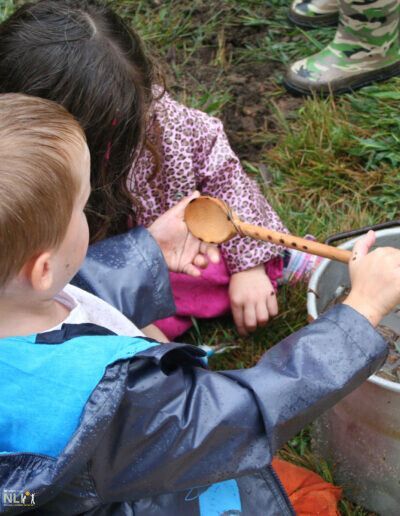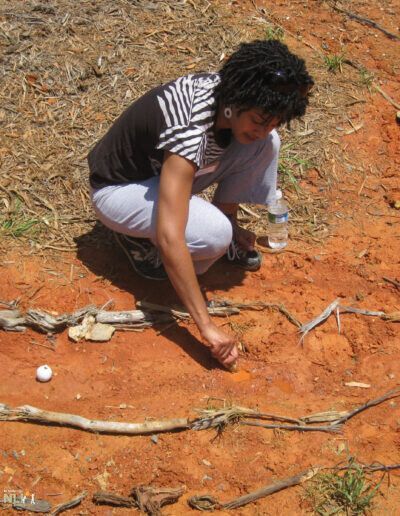34. Mud Kitchens
materials
A mud kitchen can be assembled using entirely recycled items. Engage parents by asking them to sort through kitchen cabinets to see what they can donate to the center. Visit material recycling yards for recycled equipment. Check thrift stores and yard sales. Key components include the following:
Kitchen utensils. Pots, whisks, pans, baking trays, mixing bowls, spoons, cups, strainers, ice trays — a plethora of kitchen items can be repurposed as lab equipment to encourage mud play and learning. Maximize affordances for manipulating materials by pouring, mixing, scraping, sifting, and measuring. Consider support for imaginary play such as baking and serving.
Recycled kitchen appliances. An old microwave, tea kettle, oven racks, or mini fridge help children read the mud kitchen as a place for “cooking” and experimentation (remove any cables and plugs beforehand).
Natural loose parts. Plant parts become imaginary ingredients, including sticks, leaves, petals, seeds that enhance mud kitchen play. Go on a safari around the outdoor learning environment (OLE) and talk with children about “pickables” for decorating concoctions. Plant the children’s favorite “ingredients” in your OLE garden.
Water is essential. Evaluate water sources in relation to possible mud kitchen locations. Water can be supplied in many ways, ranging from a portable reservoir to a permanent reservoir and handpump. A spring-loaded faucet or teacher-controlled trickling hose will let children be self-sufficient and simplify clean-up. Ensure that water is potable.
Dirt/soil is essential. Purchase sterile, organic garden soil from a local supplier/hardware store. Store in a tub in the “kitchen.”
Usability. All mud kitchen components/play props should be visible and reachable to encourage children’s diverse, independent play.
layout
Child-sized workspaces. Configure your child-sized workspace with countertops and recycled sinks, backs for hanging utensils, under-counter storage, elevated mixing tubs, “café” tables, sitting logs, and more!
Enclosure. The mud play setting should create a feeling of free, messy “house-play.” Make the space large enough to accommodate multiple children playing simultaneously. Enclosure can be achieved by adding backs to counters or placing them against fences to separate from adjacent settings.
Shade. Mud play is engaging and can last a long time, so protection from over-exposure to sunlight is crucial. Adequate sun protection can be achieved with shade trees, shade sails, pergolas, or roof structures.
Compatible adjacency. To enhance mud play experiences, locate mud settings near complementary settings such as informal gathering spaces with child-sized tables and chairs for “serving” and nearby plants for foraging ingredients.
Visibility. All components of the mud kitchen should be visible for adequate supervision.
Combining water play and mud play. There are no strict requirements to implement a “mud kitchen.” Some centers create settings that are loosely defined, containing a mix of water, mud, and loose parts, with a pedagogical focus on STEM. Combinations can take on linear forms that work well along OLE edges.
health and safety
Purchase organic potting soil to ensure absence of toxic or unsafe materials and to prevent children from digging up other areas of the OLE. It is advisable that children wear smocks or rain ponchos to keep clothing dry and clean. Ensure that children wash their hands after mud play and before resuming indoor activity. Remind children that their concoctions are for playing, not eating!
parent engagement
What if parents think mud play is a bad idea? Try organizing a parent workshop, engaging parents in hands-on activities and sharing evidence-based research that outlines the benefits of nature play and learning, including mud play. Recognize that some parents may never have even touched soil and consider it unhealthy. Slowly introduce hands-on activities with natural materials, soil, and mud, allowing time to discuss and feel comfortable. Suggest that playing in dirt and mud not only stimulates the imagination and social skills, but helps to build children’s immune systems. Look at the growing list of recent literature resources by well-credentialed authors on the positive impact of “dirt.”
Resources
- National Wildlife Federation. 2012. The Dirt on Dirt: How Getting Dirty Outdoors Benefits Kids.
- Asia Citro. 2015. A Little Bit of Dirt. Woodinville, WA: Innovation Press.
- Jack Gilbert & Rob Knight. 2017. Dirt is Good. New York, NY: St. Martin’s Griffin.
- Mary Ruebush. 2009. Why dirt is good: 5 ways to make germs your friends. New York, NY: Kaplan Pub.
- Maya Shetreat-Klein. 2016. The Dirt Cure. New York, NY: Atria Books.

